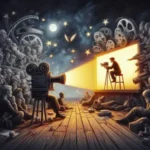In an era where identity is constantly evolving and multifaceted, film emerges as a powerful medium that reflects, challenges, and shapes our understanding of who we are.
From the nuanced portrayal of cultural backgrounds to the exploration of personal struggles and triumphs, cinema serves as a mirror to society, illuminating the intricate tapestry of identity that defines us. In “Reel Reflections: How Film Navigates the Complexities of Identity,” we embark on a journey through the silver screen, examining how filmmakers tackle themes of race, gender, sexuality, and self-discovery. By delving into iconic scenes and thought-provoking narratives, this blog post will reveal how films not only resonate with our own experiences but also foster empathy and understanding in a world marked by diversity. Join us as we explore the profound ways in which the art of storytelling on film unravels the complexities of identity, inviting viewers to reflect on their own narratives in the process.
1. Introduction: The Intersection of Film and Identity
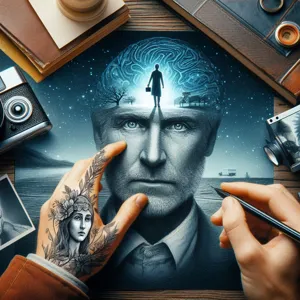
In today’s rapidly evolving world, identity is a multifaceted concept that encompasses various elements such as culture, ethnicity, gender, and personal experiences. Film, as a powerful storytelling medium, has long been at the forefront of exploring these complexities. From the earliest silent films to contemporary masterpieces, cinema reflects societal norms, challenges stereotypes, and allows viewers to engage with diverse narratives that shape our understanding of self and community.
At its core, film serves as a mirror, reflecting not just the lives of individuals but also the collective psyche of society. It presents a unique opportunity to delve into the nuances of identity, revealing how our backgrounds and experiences inform our perspectives and interactions. Through character development and plot progression, filmmakers can weave intricate tapestries that highlight the struggles, triumphs, and transformations of their protagonists, resonating with audiences on a deeply personal level.
In this exploration of identity through film, we’ll examine how various filmmakers approach the theme, highlighting key works that not only entertain but also provoke thought and dialogue. Whether it’s the poignant journey of self-discovery in a coming-of-age narrative or the exploration of cultural displacement in a globalized world, cinema offers a rich landscape for understanding the complexities of who we are and how we navigate our place in the world. Join us as we delve into the ways film captures the essence of identity, illuminating the paths we walk in our quest for self-understanding and connection with others.
2. Defining Identity in the Context of Film
In the realm of cinema, identity is not merely a backdrop; it is a vibrant, intricate tapestry that weaves together the threads of individual and collective experiences. It encompasses more than just the characters we meet on screen; it reflects the cultural, social, and historical contexts from which these narratives emerge. When we talk about defining identity in film, we delve into the multifaceted layers of self-representation, the dynamics of belonging, and the ongoing dialogue between personal and societal narratives.
Filmmakers often engage with identity through the lens of various markers such as race, gender, sexuality, and class, allowing audiences to glimpse the rich diversity of human experience. For instance, in films like “Moonlight,” we witness the protagonist’s journey of self-discovery as he navigates the complexities of his identity within the intersections of race, sexuality, and socioeconomic status. This nuanced portrayal not only highlights the struggles faced by individuals in understanding who they are but also invites viewers to reflect on their own identities and the societal structures that shape them.
Moreover, identity in film is fluid, often evolving alongside the characters’ journeys. It challenges static definitions and encourages a deeper understanding of the self as a dynamic entity that is constantly influenced by relationships and environments. As we explore this theme, we uncover how films function as a mirror to our own lives, prompting introspection and prompting important conversations about how we define ourselves and how we see others.
In this context, film becomes a powerful tool for exploring identity, offering diverse narratives that expand our understanding of what it means to be human in a world that is often divided by differences. By analyzing these representations, we can begin to appreciate the complexities of identity, realizing that every story told on screen has the potential to resonate with our own experiences and perceptions, ultimately fostering empathy and connection across diverse audiences.
3. Historical Perspectives: Early Cinema and Identity Representation
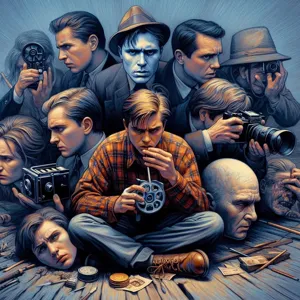
In the realm of early cinema, the portrayal of identity was intricately intertwined with the social and cultural dynamics of the time. As film emerged as a powerful medium in the late 19th and early 20th centuries, it reflected and shaped societal perceptions of race, gender, and class. Initial cinematic narratives often perpetuated existing stereotypes, offering a narrow lens through which identity was viewed.
For instance, silent films frequently depicted women in limited roles—damsels in distress or objects of desire—reinforcing traditional gender norms and expectations. Similarly, racial minorities were often relegated to caricatures, their complexities and narratives simplified to fit the prevailing ideologies of the time. The infamous “Birth of a Nation” (1915) served as a stark example, glorifying the Ku Klux Klan while demonizing African American characters, solidifying harmful stereotypes that would echo through the decades.
Yet, amid these troubling representations, early cinema also planted the seeds for challenging the status quo. Filmmakers like Oscar Micheaux, an African American director, sought to counteract negative portrayals by creating films that centered on Black experiences, showcasing the richness of identity beyond the limitations imposed by mainstream narratives. His works, such as “Within Our Gates” (1920), not only provided a voice for marginalized communities but also highlighted the struggles and triumphs inherent in their identities.
As audiences began to engage more critically with film, the representation of identity became a topic of discussion and dissent. The cultural shifts of the 1960s and 70s, marked by social movements advocating for civil rights and gender equality, began to influence filmmakers to explore more nuanced portrayals of identity. The evolution from stereotypical representations to complex characterizations mirrored society’s quest for understanding the multifaceted nature of identity.
In examining early cinema through this lens, we see a dual narrative—a reflection of societal prejudices and a burgeoning resistance against them. This historical perspective not only illuminates the challenges faced in accurately representing identity but also sets the stage for the ongoing dialogue around representation in film today. As we continue to dissect the layers of identity within cinematic storytelling, it becomes clear that the journey of film is as much about reflection as it is about revolution.
4. Modern Narratives: How Contemporary Films Address Identity
In today’s cinematic landscape, contemporary films are carving out new narratives that explore the multifaceted nature of identity in ways that resonate deeply with audiences. These films delve into the intricacies of personal and cultural identity, often challenging traditional norms and highlighting the fluidity of self-perception in an ever-evolving society.
Modern filmmakers are pushing boundaries by featuring diverse characters whose identities encompass a spectrum of race, gender, sexuality, and socio-economic backgrounds. For instance, films like *Moonlight* and *The Farewell* poignantly illustrate the struggles of navigating conflicting cultural expectations and personal desires. They offer a raw and authentic glimpse into how identity is shaped by both internal conflicts and external societal pressures.
Moreover, contemporary narratives often embrace intersectionality, recognizing that identity is not a singular experience but rather a tapestry woven from various threads of influence. Movies such as *Crazy Rich Asians* and *Portrait of a Lady on Fire* celebrate the richness of cultural identity while examining the impact of privilege and societal norms. These stories invite viewers to confront their own biases and preconceptions, fostering empathy and understanding.
Additionally, the rise of digital media and streaming platforms has provided a broader canvas for storytelling. Independent films like *Eighth Grade* and *The Half of It* speak to the coming-of-age experience in the age of social media, capturing the anxieties and triumphs of forming an identity under the watchful gaze of a digital audience. By addressing themes like belonging, self-discovery, and the pressure to conform, these films resonate with a generation grappling with their place in the world.
In essence, modern narratives in film serve not only as a reflection of society but also as a catalyst for change. By bringing diverse identities to the forefront and challenging stereotypes, contemporary filmmakers are reshaping the dialogue around identity, encouraging audiences to embrace complexity and celebrate the beauty of difference. Through this lens, films become more than just entertainment; they transform into powerful vehicles for exploration and understanding, guiding us through the labyrinth of who we are and who we can become.
5. Intersectionality: Exploring Multiple Identities in Film
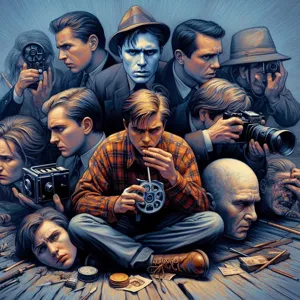
Intersectionality in film is a rich and multifaceted concept that delves into the intricate layers of identity that shape our experiences. This idea recognizes that individuals are not defined by just one aspect of their identity—such as race, gender, sexuality, or socioeconomic status—but rather by the complex interplay of these various dimensions. In cinema, this intersectional lens allows filmmakers to craft narratives that reflect the true diversity of human experience, moving beyond simplistic stereotypes and broad generalizations.
Consider films that portray characters who navigate multiple identities simultaneously, such as a queer woman of color or a disabled veteran. These characters exist at the crossroads of different societal expectations and challenges, which can lead to unique conflicts and revelations. By showcasing these nuanced experiences, filmmakers illuminate the systemic inequalities that persist in society and encourage audiences to engage with the world from a more empathetic and informed perspective.
For example, the critically acclaimed film “Moonlight” beautifully illustrates intersectionality by exploring the life of a young Black man grappling with his identity amidst the complexities of race, sexuality, and poverty. Through its poignant storytelling and rich character development, “Moonlight” invites viewers to consider how intersecting identities can shape one’s journey and the way society perceives them. This exploration of intersectionality not only enriches the narrative but also fosters a deeper understanding of the struggles faced by marginalized communities.
As we continue to see a shift in the film industry towards more inclusive storytelling, it becomes essential for creators to embrace the concept of intersectionality. By doing so, they not only enhance the authenticity of their narratives but also pave the way for greater representation on screen, ensuring that all voices are heard and validated. Ultimately, the exploration of multiple identities in film serves as a powerful reminder of the beauty and complexity of the human experience, urging us to reflect on our own identities and the diverse tapestry of stories that surround us.
6. Case Study: Iconic Films That Challenge Identity Norms
In the vast landscape of cinema, certain films stand out not just for their storytelling prowess but for their audacious exploration of identity norms. These iconic films serve as cultural touchstones, challenging viewers to reconsider preconceived notions of race, gender, sexuality, and class. By delving into the complexities of identity, these movies ignite conversations that resonate long after the credits roll.
One such film is **”Moonlight,”** a poignant coming-of-age story that chronicles the life of a young Black man grappling with his identity amidst the intersections of race, masculinity, and sexual orientation. Through its evocative visuals and intimate storytelling, “Moonlight” invites audiences to empathize with the protagonist’s struggles and triumphs, ultimately portraying identity as fluid and multifaceted. The film’s groundbreaking representation of Black queer experiences not only earned it critical acclaim but also solidified its place in cinematic history.
Another powerful example is **”Paris is Burning,”** a documentary that provides an unfiltered glimpse into the vibrant ball culture of New York City in the 1980s. Through the lens of drag queens and LGBTQ+ individuals, the film navigates themes of race, class, and gender identity, highlighting the struggles and triumphs of a marginalized community. Its raw honesty and captivating storytelling challenge viewers to confront societal norms while celebrating the beauty of self-expression and authenticity.
Additionally, **”The Handmaiden,”** a South Korean psychological thriller, intricately weaves themes of gender and class identity, subverting traditional narratives through its plot twists and complex female characters. By exploring the dynamics of power and desire against a backdrop of societal expectations, the film encourages viewers to question the roles assigned to them by society and the fluid nature of identity itself.
These films, among others, not only entertain but also provoke thought and inspire dialogue about identity in all its forms. They remind us that identity is not a static construct but rather a dynamic interplay of personal experiences, societal influences, and cultural narratives. As we reflect on these cinematic masterpieces, we are compelled to examine our own perceptions of identity and how they shape our understanding of ourselves and others in an ever-evolving world.
7. The Role of Character Development in Understanding Identity
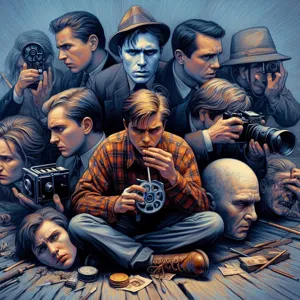
Character development plays a pivotal role in exploring and portraying the complexities of identity in film. As audiences, we often find ourselves drawn to characters whose journeys reflect our own struggles, triumphs, and transformations. These narratives become a mirror, allowing us to examine the multifaceted layers of identity—be it cultural, sexual, gender-based, or personal.
In well-crafted films, character arcs provide insight into the internal and external conflicts that shape who we are. Take, for instance, the gradual evolution of a character grappling with their cultural heritage. Through their interactions with family, friends, and society, viewers witness the struggle between tradition and modernity, acceptance and alienation. This journey not only deepens our understanding of that character but also invites us to reflect on our own identities and the influences that mold them.
Moreover, character development can illuminate the intersectionality of identity, showcasing how different aspects of a character’s life intertwine. A film may present a protagonist who navigates the complexities of being a woman of color in a predominantly white industry. As the story unfolds, we see how systemic barriers, personal aspirations, and societal expectations collide, shaping her identity in profound ways. This nuanced portrayal fosters empathy and understanding, allowing audiences to engage with experiences outside their own.
Films that prioritize character development also challenge stereotypes and broaden our perspectives. By presenting fully realized characters with depth and nuance, filmmakers can dismantle one-dimensional portrayals and offer a more authentic representation of diverse identities. The result is a richer cinematic experience that resonates deeply with viewers, encouraging them to question preconceived notions and embrace the fluidity of identity.
Ultimately, character development in film serves as a powerful tool for exploring the complexities of identity. Through the lens of well-crafted narratives, audiences embark on a journey of self-discovery and connection, reaffirming the idea that our identities are not fixed but rather a dynamic interplay of experiences, choices, and relationships.
8. Cinematic Techniques: How Filmmakers Convey Identity Complexity
Cinematic techniques offer filmmakers a powerful toolbox to explore and convey the intricate nuances of identity. From the use of lighting and color to framing and editing, these elements work harmoniously to reflect the multifaceted nature of characters and their journeys. For instance, consider how lighting can evoke emotional states and symbolize a character’s internal struggles. A dimly lit scene might suggest confusion or despair, while vibrant hues can indicate empowerment or joy.
Framing techniques also play a pivotal role in shaping audience perceptions of identity. A character positioned at the edge of the frame might visually represent feelings of isolation or alienation, while a close-up can create intimacy and invite viewers to connect deeply with a character’s personal experiences. Filmmakers often employ wide shots to depict a character’s relationship to their environment, emphasizing how context and surroundings shape identity.
Editing techniques, such as jump cuts or montages, can illustrate the disjointed experiences often faced by individuals navigating multiple identities. These rapid transitions can mirror the chaos of internal conflict or the fluidity of identity, allowing audiences to grasp the complexity of the characters’ lives in a visceral way.
Additionally, sound design and music further enhance the narrative of identity. A haunting score might reflect themes of loss or longing, while upbeat tracks can convey joy and connection. The interplay of sound and visuals creates an immersive experience, inviting viewers to not just observe but feel the weight of the characters’ identities.
Through these artistic choices, filmmakers transcend mere storytelling, crafting a rich tapestry that reveals how identity is not a singular narrative but a dynamic interplay of influences, struggles, and triumphs. By employing these cinematic techniques, films can resonate deeply with audiences, encouraging reflection and dialogue about the complexities of identity in a diverse world.
9. Audience Reception: How Viewers Relate to Identity in Film
When it comes to understanding the complexities of identity in film, audience reception plays a pivotal role. Viewers bring their own backgrounds, experiences, and perspectives to the cinematic experience, which influences how they interpret characters and narratives. This interaction creates a rich tapestry of meanings, where individual interpretations can vary widely, even for the same film.
For instance, consider a film that explores themes of racial identity. A viewer from a minority background may connect deeply with the struggles portrayed on screen, resonating with the nuances of cultural representation and the quest for belonging. In contrast, a viewer from a different demographic may find themselves reflecting on their own privileges or biases, leading to a different understanding of the film’s message. This divergence in reception highlights how identity is not a static concept, but rather a dynamic interplay between the film’s content and the audience’s personal context.
Moreover, the rise of social media has transformed how audiences engage with films. Viewers now have platforms to share their thoughts and reactions in real-time, sparking discussions that can shape a film’s legacy. Hashtags, threads, and online forums become spaces where audiences dissect identity portrayals, challenge stereotypes, and advocate for more authentic representation. This communal engagement doesn’t just enhance the viewing experience; it can also influence filmmakers, prompting them to consider how their stories resonate with diverse audiences.
Ultimately, the way viewers relate to identity in film underscores the importance of representation and authenticity in storytelling. It reminds us that each film is a mirror reflecting not just the lives of its characters, but also the myriad identities of those who watch them. As audiences continue to engage with films that tackle complex identity issues, they contribute to a broader dialogue about who we are, who we want to be, and how our stories intertwine in the fabric of society.
10. The Influence of Cultural Context on Identity Representation
Cultural context plays a pivotal role in shaping the narratives and representations of identity within film. Every society, with its unique history, traditions, and values, influences how characters are portrayed and how their identities are formed and understood. For instance, films set in multicultural environments often reflect the tension and synergy between various cultural identities, showcasing the struggles and triumphs of individuals as they navigate their sense of self amidst differing societal expectations. These narratives not only highlight the diversity of experiences but also emphasize the significance of cultural heritage in shaping an individual’s identity.
Consider the impact of regional storytelling on character development. In films like “Black Panther,” the rich cultural tapestry of African traditions informs the identity of characters, creating a narrative that resonates deeply with audiences both within and outside of the continent. By intertwining cultural motifs with personal journeys, filmmakers can evoke a profound sense of belonging and pride that transcends borders. Conversely, films that fail to accurately represent their cultural contexts risk perpetuating stereotypes or oversimplifying complex identities, often leading to backlash from communities depicted onscreen.
The nuances of cultural context are further enriched by globalization. As films are distributed worldwide, they often confront the challenge of appealing to diverse audiences while remaining true to their cultural roots. This balancing act can lead to innovative storytelling techniques that blend elements from different cultures, offering a fresh perspective on identity. For instance, the rise of cross-cultural collaborations in film has led to narratives that reflect a more globalized identity, where characters grapple with the intersections of tradition and modernity.
Ultimately, the influence of cultural context on identity representation in film is both a reflection of and a commentary on the world we live in. By examining how different cultures shape the stories we tell, filmmakers not only provide insight into the complexities of identity but also foster a greater understanding and appreciation of the myriad ways individuals navigate their existence within a diverse society. Through thoughtful representation, film becomes a powerful medium for exploring and celebrating the multifaceted nature of identity in all its forms.
11. Documentary Films: Real Stories and Authentic Identities
Documentary films serve as a powerful lens through which we can explore the complexities of identity, often shining a light on real stories that resonate deeply with audiences. Unlike their fictional counterparts, documentaries delve into the lives of actual individuals, communities, and cultures, presenting an unfiltered view of the human experience. This authenticity fosters a unique connection between the viewer and the subject, allowing for profound understanding and empathy.
From intimate portraits of everyday lives to sweeping examinations of social movements, documentary filmmakers often tackle themes of race, gender, sexuality, and socio-economic status with a raw honesty that can be both enlightening and challenging. Take, for instance, films like “Won’t You Be My Neighbor?” which explores the compassionate identity of Fred Rogers, or “13th,” which unpacks the historical complexities of race in America. Each film not only informs but also invites audiences to reflect on their own identities in relation to those being portrayed.
Moreover, documentaries have the power to amplify voices that are often marginalized or overlooked in mainstream media. By showcasing diverse perspectives, they encourage viewers to confront their biases and broaden their understanding of what it means to belong in a multifaceted world. The stories told through the lens of a camera can spark conversations, challenge stereotypes, and inspire change—reminding us that identity is not a singular narrative but a tapestry woven from countless threads of experience.
In a society that frequently grapples with issues of identity, documentary films stand as crucial storytellers, offering insights that are not only informative but transformative. They remind us that every story matters, and every identity holds significance. By embracing these real stories, we not only enrich our understanding of the world but also cultivate a deeper appreciation for the intricate mosaic of human existence.
12. Global Perspectives: Identity in International Cinema
In the realm of international cinema, filmmakers from diverse backgrounds weave intricate narratives that reflect the multifaceted nature of identity across cultures. Global perspectives in film illuminate how cultural, social, and political contexts shape individual and collective identities, offering audiences a rich tapestry of experiences that challenge monolithic notions of self.
From the vibrant streets of Mumbai depicted in Bollywood musicals to the haunting landscapes of Scandinavian dramas, international films explore themes of belonging, displacement, and transformation. For instance, the poignant storytelling found in films like “The Lunchbox” delves into the everyday lives of ordinary people, revealing how culinary traditions and personal connections can transcend societal barriers. Similarly, “Parasite,” a South Korean masterpiece, critiques class divisions and the pursuit of identity within the constraints of economic disparity, showcasing the universality of human struggle and aspiration.
Moreover, films such as “Roma,” directed by Alfonso Cuarón, offer a glimpse into the intimate lives of domestic workers, shedding light on issues of race, class, and gender through a deeply personal lens. In doing so, they invite viewers to reflect on their own identities and the broader societal structures that shape them.
International cinema also serves as a platform for underrepresented voices, amplifying narratives that might otherwise remain unheard. By showcasing stories from indigenous communities, LGBTQ+ filmmakers, and immigrant experiences, these films challenge dominant narratives and foster empathy and understanding.
As audiences engage with these global stories, they are encouraged to reconsider their own identities in relation to others. The interplay of culture, history, and personal experience in international cinema not only enriches our understanding of the world but also underscores the shared humanity that connects us all. Through this lens, film becomes a powerful medium for exploring the complexities of identity, prompting reflection, dialogue, and ultimately, a deeper appreciation for the diverse narratives that shape our lives.
13. The Future of Identity in Film: Trends and Predictions
As we stand on the cusp of a new era in filmmaking, the future of identity in film is poised to evolve in ways that reflect the ever-changing landscape of society. Emerging trends hint at a more inclusive and nuanced exploration of identity, promising to challenge traditional narratives and expand the representation of diverse experiences on screen.
One significant trend is the rise of intersectionality in storytelling. Filmmakers are increasingly recognizing that identity is multifaceted—encompassing race, gender, sexuality, socio-economic status, and more. This awareness is leading to stories that intertwine these elements, allowing characters to be portrayed in a more holistic manner. Expect to see narratives that celebrate the complexities of identity, providing audiences with richer, more relatable characters who navigate the intricacies of their lives against the backdrop of a diverse world.
Moreover, technology is playing a pivotal role in shaping how identity is represented and experienced in film. Virtual reality (VR) and augmented reality (AR) are opening new avenues for storytelling, enabling viewers to step into the shoes of characters and experience their journeys firsthand. This immersive approach could redefine empathy in film, allowing audiences to engage with identities that differ vastly from their own, fostering understanding and connection.
Additionally, the rise of streaming platforms has democratized access to storytelling, giving a voice to previously underrepresented creators. Independent filmmakers from various backgrounds now have the opportunity to share their unique perspectives, leading to a broader array of stories that reflect the global tapestry of identities. This shift not only enriches the cinematic landscape but also encourages mainstream studios to rethink their content strategies in order to remain relevant and resonate with an increasingly diverse audience.
As we look ahead, we can anticipate a film industry that embraces complexity and authenticity in its portrayal of identity. With audiences becoming more vocal about the need for representation and inclusivity, filmmakers will likely respond by pushing boundaries and exploring themes that resonate deeply with the human experience. The future of identity in film promises to be a vibrant tapestry of stories that reflect the richness of our collective existence, challenging perceptions and igniting conversations that will undoubtedly shape the cultural narrative for generations to come.
14. Conclusion: The Power of Film to Shape Our Understanding of Identity
In conclusion, the power of film to shape our understanding of identity cannot be overstated. Through its intricate narratives, diverse characters, and compelling visuals, cinema serves as a mirror reflecting the multifaceted nature of human existence. It delves deep into the layers of identity—exploring themes of race, gender, sexuality, and cultural background—allowing audiences to engage with perspectives that may differ from their own.
Films like “Moonlight,” “Parasite,” and “The Farewell” illustrate how storytelling can transcend boundaries, inviting viewers into the intimate lives of characters navigating their identities in a complex world. These stories not only entertain but also educate, provoking thought and empathy, fostering a greater understanding of the shared human experience.
Moreover, film has the unique ability to challenge societal norms and ignite conversations around identity, prompting audiences to reflect on their own beliefs and biases. As we immerse ourselves in these cinematic journeys, we are reminded of the importance of representation and the rich tapestry of identities that exist in our global society.
Ultimately, the impact of film extends beyond the screen, shaping our perceptions and encouraging us to embrace the complexities of who we are and who we can become. The stories we watch can inspire change, foster connection, and cultivate a deeper appreciation for the diverse identities that enrich our world. In this way, cinema remains not only a powerful art form but also an essential catalyst for understanding and celebrating the complexities of identity.
15. Call to Action: Engaging with Film as a Tool for Identity Exploration
As we draw this exploration of film and identity to a close, it’s essential to consider how we can actively engage with cinema as a powerful tool for personal and collective identity exploration. Film is not just a medium for entertainment; it serves as a mirror reflecting the myriad facets of our identities—cultural, social, and personal. It invites us to confront our biases, embrace diversity, and understand the complexities of the human experience.
To fully harness the potential of film in this journey, start by selecting movies that resonate with your own experiences or challenge your perspectives. Seek out international films that delve into cultures different from your own, or documentaries that spotlight marginalized voices. These narratives can spark conversations about identity and foster empathy, allowing us to step into the shoes of others and view the world through new lenses.
Additionally, consider creating or joining discussion groups where participants can share their insights and reactions to various films. This communal aspect of film-watching can deepen your understanding and appreciation of how identity is constructed and represented on screen. Social media platforms also offer an excellent space for dialogue—share your thoughts, engage with film critiques, or explore hashtags that focus on identity in cinema.
Finally, don’t shy away from creating your own content. Whether through filmmaking, writing, or art, express how your identity intersects with the themes you encounter in films. This self-reflective practice can be liberating and empowering, enabling you to articulate your unique narrative while contributing to the broader conversation about identity in the cinematic landscape.
In essence, engaging with film as a tool for identity exploration is an invitation to embark on a transformative journey. By actively choosing to analyze, discuss, and create, we can deepen our understanding of ourselves and others, making the cinematic experience not just a form of escapism, but a profound exploration of what it means to be human. So grab your popcorn, dim the lights, and prepare for a journey that will not only entertain but also enlighten.
In conclusion, “Reel Reflections: How Film Navigates the Complexities of Identity” reveals the profound impact that cinema has on our understanding of self and society. Through its ability to tell diverse stories, challenge stereotypes, and explore the multifaceted nature of identity, film serves as a mirror reflecting our experiences, struggles, and triumphs. As we engage with these cinematic narratives, we not only gain insight into the lives of others but also come to better understand our own identities in relation to the world around us. We encourage you to explore the films we’ve discussed, engage in conversations about their themes, and reflect on how they resonate with your own journey. In a world where identity is ever-evolving, let the power of film inspire you to embrace your own story while appreciating the rich tapestry of human experience that surrounds us all.


